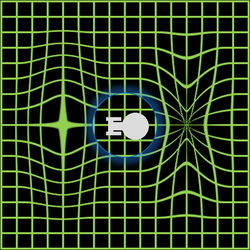Technology in Star Trek
This article has multiple issues. Please help improve it or discuss these issues on the talk page. (Learn how and when to remove these messages)
|
The technology in Star Trek has borrowed many ideas from the scientific world. Episodes often contain technologies named after real-world scientific phenomena, such as tachyon beams, baryon sweeps, quantum slipstream drives, and photon torpedoes. Some of the technologies created for the Star Trek universe were done so out of financial necessity. For instance, the transporter was created because the limited budget of Star Trek: The Original Series (TOS) in the 1960s did not allow expensive shots of spaceships landing on planets.[1][page needed]
Discovery Channel Magazine stated that cloaking devices, faster-than-light travel, and dematerialized transport were only dreams at the time TOS was made, but physicist Michio Kaku believes all these things are possible.[2] William Shatner, who portrayed James T. Kirk in TOS, believes this as well, and went on to co-write the book I'm Working on That, in which he investigates how Star Trek technology was becoming feasible.
Subspace

In the Star Trek fictional universe, subspace is a feature of space-time that facilitates faster-than-light transit, in the form of interstellar travel or the transmission of information.[3] Faster-than-light warp drive travel via subspace works similarly to the Alcubierre Drive, but obeys different laws of physics. Subspace has also been adopted and used in other fictional settings, such as the Stargate franchise, The Hitchhiker's Guide to the Galaxy series, and Descent: Freespace.
In most Star Trek series, subspace communications are a means to establish nearly instantaneous contact with people and places that are light years away. The physics of Star Trek describe infinite speed (expressed as warp factor 10) as an impossibility; as such, even subspace communications which travel at speeds over Warp 9.9 may take hours or weeks to reach certain destinations. In the Star Trek universe subspace signals do not degrade with the square of the distance as do other methods of communication utilizing conventional bands of the electromagnetic spectrum (i.e. radio waves), so signals sent from a great distance can be expected to reach their destination at a predictable time and with little relative degradation (barring any random subspace interference or spatial anomalies).[citation needed]
In the Star Trek franchise, subspace communications have a limit of just over 20 light years before they must be boosted, although this limitation has been ignored in several storylines.[citation needed]
See also
- Ansible
- Hyperspace (science fiction)
- Time travel in fiction
- Warp drive
- Wormholes
- Quantum energy teleportation
Star Trek technologies
- Cloaking device
- Communicator (original seen in TOS; similar to the modern-day mobile phone)
- Holodeck
- Replicator
- Tractor beam
- Transporter
- Universal translator
References
Further reading
- David A. Batchelor (2009). "The Science of Star Trek". NASA Goddard Space Flight Center.
- C.W. Nevius (June 29, 2006). "Astrophysics taking off on Superman". San Francisco Chronicle.
- Keay Davidson (August 29, 2005). "Military examines "beaming up" data, people. Critics say its extreme computing, energy needs keep teleportation unlikely for now". San Francisco Chronicle.
- A. Smith (1991). "Six Dimensions and Star Trek". Science Education. U.S. Department of Energy.
- Star Trek Inconsistencies. Ex Astris Scientia
- Lawrence M. Krauss (1995). The Physics of Star Trek. ISBN 0-06-097710-8.
- Alan N. Shapiro (2004). Star Trek: Technologies of Disappearance. ISBN 978-3-930064-16-8.
- Mark E. Lasbury: The realization of Star Trek technologies. Springer, Cham 2017, ISBN 9783319409146.
External links

